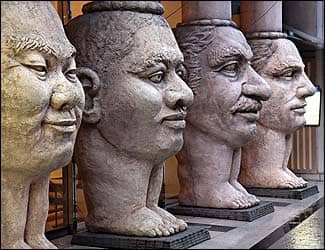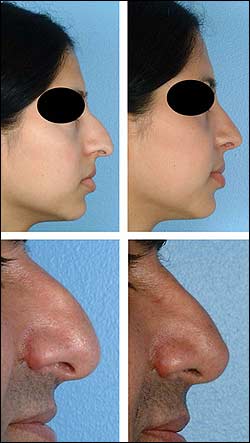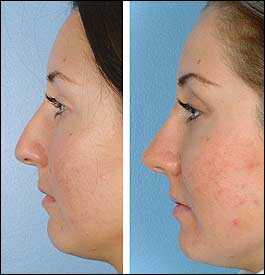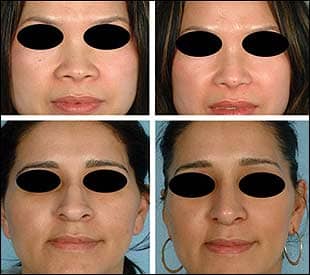 |
The business of fixing noses is tough and challenging for many reasons. First, the structures upon which techniques are applied are awkward to manipulate. Bone is rigid, cartilage is floppy, and both can only be altered so far before the nose becomes unstable.
Second, after fresh surgery relentless soft-tissue contracture places all of the surgical work under stress. Unless the infrastructure of the nose is stable and strong at the end of surgery, these forces can cause collapse, pinching, irregularities, and breathing problems in patients’ noses.
Third, there is an incredible diversity of nasal anatomic forms. The starting point from which each rhinoplasty begins varies tremendously from person to person. Finally, there is a wide range of individual patient goals and aesthetic preferences toward which the rhinoplasty surgeon must strive. This last point has become increasingly important as a broader base of patients seek cosmetic surgery.
With globalization, the rise of cosmetic surgery internationally, and our ever-diversifying patient base in the United States, rhinoplasty surgeons must pay more attention to the individual and ethnic differences of our patients, both anatomically and aesthetically.
This article highlights pearls that have helped me in my rhinoplasty practice for patients of different ethnic backgrounds. I will review four case studies highlighting variations of nasal form with respect to different ethnic backgrounds and discuss the strategies employed to achieve favorable results for these patients.
ETHNIC ANATOMICAL VARIATIONS
It is overly simplistic to classify a non-Caucasian nose as an “ethnic” nose to which “ethnic rhinoplasty” principles apply. Two noses from two different ethnic backgrounds are likely to be as different from each other as they are from a Caucasian nose. In addition, significant variations in facial features are found within any given ethnic group.
Three broad nasal morphology types have been used to describe ethnic variations.
The leptorrhine (“tall and thin”) nose is associated with Caucasian or Indo-European descent. Because it is the most extensively studied in modern nasal analysis, it also inevitably becomes the reference point for comparison when studying noses of different ethnicities. Only in recent history have non-Caucasian standards of nasal analysis been developed for specific ethnic groups.
The platyrrhine (“broad and flat”) nose is associated with African descent. It is characterized by thick skin, a low radix, a short dorsum, a bulbous and under-projected tip, and flared nostrils.
An analysis of the African-American female nose shows that compared to the Caucasian standard for nasal analysis, the columella-to-lobule ratio is decreased and the alar width relative to the intercanthal distance is increased.
 |
| Figure 1. Before (left) and after (right). Rhinoplasty patients with dorsal reduction and preservation of some convexity. The female patient retained a subtle curvature with concurrent tip elevation. The male patient desired a stronger dorsal curve to be left intact. |
The mesorrhine (“intermediate”) nose has features intermediate between the leptorrhine and the platyrrhine nose. The “typical” Asian or Latino nose is commonly regarded as mesorrhine, with a low radix, variable anterior dorsal projection, a rounded and underprojected tip, and rounded nostrils.
In my practice, patients of different backgrounds tend to not want to strive for measurements and metrics consistent with a Caucasian leptorrhine nose. Rather, many patients prefer to soften certain features of their nose while retaining some of their “ethnic identity.”
CASE 1: CONVEX PROFILE PRESERVATION
The classic Caucasian ideal for the aesthetic nasal profile describes a straight-to-slightly concave contour for a woman and a straight-to-slightly convex contour for a man.
In my view, there is tremendous variation in aesthetic preference among patients of different backgrounds when it comes to this issue in rhinoplasty.
Many patients possess a strong, high dorsal convexity and wish to soften this feature while preserving some degree of outward curvature.
Though some individuals (even Caucasians) opt for this “convexity preservation” because they believe it confers a more natural, less operated appearance, other patients believe it lets them retain some of their familial or ethnic features.
Preserving some convexity to the dorsal profile of the nose requires that the surgeon and patient reach a consensus on the degree and location of the desired curvature. Preoperative digital image morphing is extremely helpful in such situations to arrive at a common goal.
Technically, the actual dorsal reduction must be performed more carefully than in surgery, with the goal to achieve a straight contour. Middle-vault dorsal trimming is better performed through an external rhinoplasty approach in such cases, in order to visually confirm the desired curvature. Incremental, progressive trimming is also helpful to achieve a precise result.
Osseous reduction should be performed just as judiciously and gradually, utilizing conservative dorsal osteotomies and rasping. Any significant osseous open roof should be addressed with lateral osteotomies to close the gap and a cartilaginous open closed with spreader grafts. (In these cases, the spreader grafts should be trimmed to match the curved contour of the dorsum—see Figure 1).
CASE 2: THICK SKIN PROFILE ALIGNMENT
In other cases, patients with thick skin may actually prefer to have a straight or even slightly concave profile. This underscores the concept that patients of various backgrounds can possess quite a range of aesthetic goals, even from within the same nationality, ethnicity, or the same family. For example, I operated on two sisters, one who wanted a straight profile and one who wanted to keep her convexity.
THREE NASAL TYPES
Leptorrhine—associated with Caucasian or Indo-European descent. Extensively studied in modern nasal analysis, this type is the reference point for comparison when studying noses of different ethnicities.
Platyrrhine—associated with African descent and characterized by thick skin, a low radix, a short dorsum, a bulbous and underprojected tip, and flared nostrils.
Mesorrhine—has features intermediate between the leptorrhine nose and the platyrrhine nose. The “typical” Asian or Latino nose is commonly regarded as mesorrhine, with a low radix, variable anterior dorsal projection, a rounded and underprojected tip, and rounded nostrils.
When a patient with thick skin and a preexisting dorsal convexity wants to have a straight profile, simple dorsal reduction is unlikely to work as a stand-alone technique. This is because the thick skin/soft-tissue envelope will not drape tightly onto the lowered infrastructure of the nose. In thin-skin patients, more aggressive reduction can be performed since the soft-tissue envelope will behave like a silk sheet covering a sculpture, transmitting the desired contour changes made to the infrastructure of the nose.
In a thick-skin patient, the skin acts more like a piece of leather covering the same sculpture, the stiffness and noncompliance of the soft tissue obscuring the changes made to the bone and cartilage. This situation causes an accumulation of dorsal and supratip soft-tissue fullness and undesired convexity—the so-called polybeak deformity.
For the thick-skin patient with dorsal convexity, in order to create a straight profile the surgeon must balance dorsal reduction with augmentation at the nasal tip and/or radix.
By elevating the relative low points along the profile, less reduction is necessary at the convex high point of the dorsum. The skin is then better able to drape true to the underlying structure of the nose, even if that skin is thick.
Tip elevation may be performed either through mobilization and suture advancement of the lower lateral crura forward relative to a midline structural graft (caudal septal extension or columellar strut) or by using a graft to build on the native domes (shield or other onlay graft). Radix elevation may be performed by precise placement of a cartilage graft within a tight pocket under the soft-tissue envelope at the root of the dorsum (Figure 2).
CASE 3: THICK SKIN FRONTAL NARROWING
Another challenge with thick-skin rhinoplasty patients of various backgrounds is how to create refinement and narrowing on the frontal view.
As described above, thicker skin, flatter lower cartilages, lower bridges, and wider flared nostrils characterize platyrrhine and mesorrhine noses.
Global narrowing of the nose should be approached systematically in such patients. If the osseous base is wide, conservative lateral and medial osteotomies may be performed to reduce some width. Because the upper nasal sidewall skin of the nose tends to be thinner than in the tip, supratip, or radix (even in a thick-skin patient), the skin in the bony vault is more apt to drape as long as the degree of narrowing is not excessive.
 |
 |
| Figure 2. Before (left) and after (right). A thick-skin patient sought slight concavity to profile. It was achieved through conservative dorsal reduction, and slight tip and radix elevation. | Figure 3. Before (left) and after (right). Thick-skin patients with osseous base reduction, alar base reduction, and projection of dorsum and tip to narrow the frontal view of the nose. |
At the nasal alar base, the thickness of the skin envelope is less of a limitation since it is the actual skin and soft tissue that is excised and repaired for most forms of base reduction.
Details of alar base reduction require a separate article to describe the nuances of the technique, but in general, conservative, meticulous measurement, planning, and execution are needed to achieve good results.
|
See also “Do It To Me One More Time” by David W. Kim, MD, FACS, in the February 2008 issue of PSP. |
 |
|
plasticsurgerypractice.com |
|
Undercorrection is always better than overcorrection in such cases, in order to prevent unnatural results, nasal obstruction, or poor scarring.
With regard to narrowing the mid-dorsum, supratip, and tip, pure cartilage-narrowing techniques are likely to fail, as the thick-skin envelope will obscure the changes created.
Instead, increasing the projection of the dorsum and tip area will allow for this narrower contour to push into and transmit through the thick-skin envelope. Onlay grafting of the dorsum or dorsally extended spreader grafts, as well as the tip techniques described above, are useful in these cases (Figure 3).
CONCLUSION
A “cookie cutter” approach to rhinoplasty not only leads to surgical complications, but now more than ever it is a culturally insensitive way to approach this operation.
The modern rhinoplasty surgeon must weigh both anatomical and aesthetic variations of patients of different backgrounds in planning for and executing rhinoplasty in order to achieve consistently favorable results.
David W. Kim, MD, FACS, is director of the Division of Facial Plastic and Reconstructive Surgery in the Department of Otolaryngology, Head and Neck Surgery at the University of California, San Francisco. He is certified by both the American Board of Facial Plastic and Reconstructive Surgery and the American Board of Otolaryngology-Head and Neck Surgery. Kim is also a fellow of the American College of Surgeons. He can be reached at (415) 885-7700.



